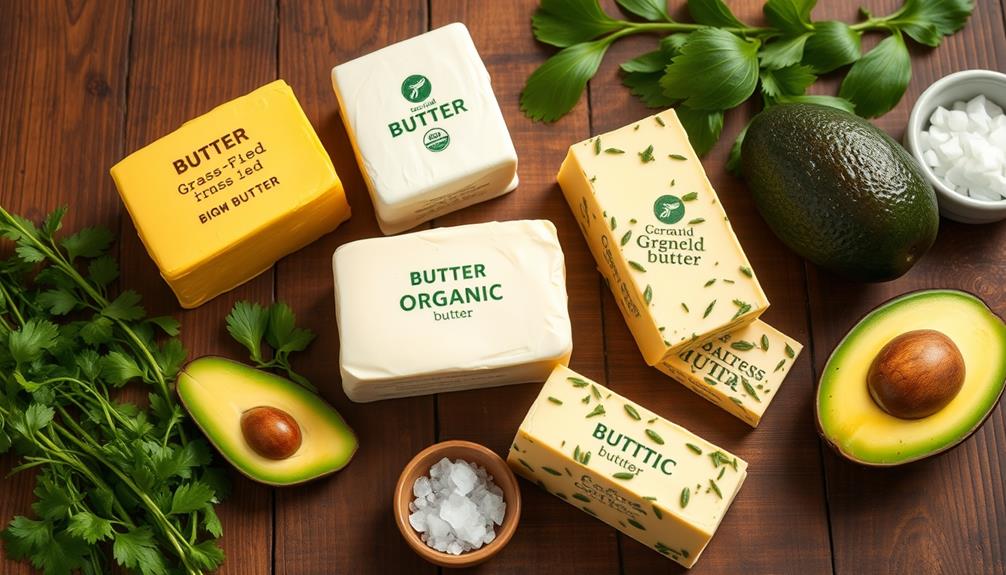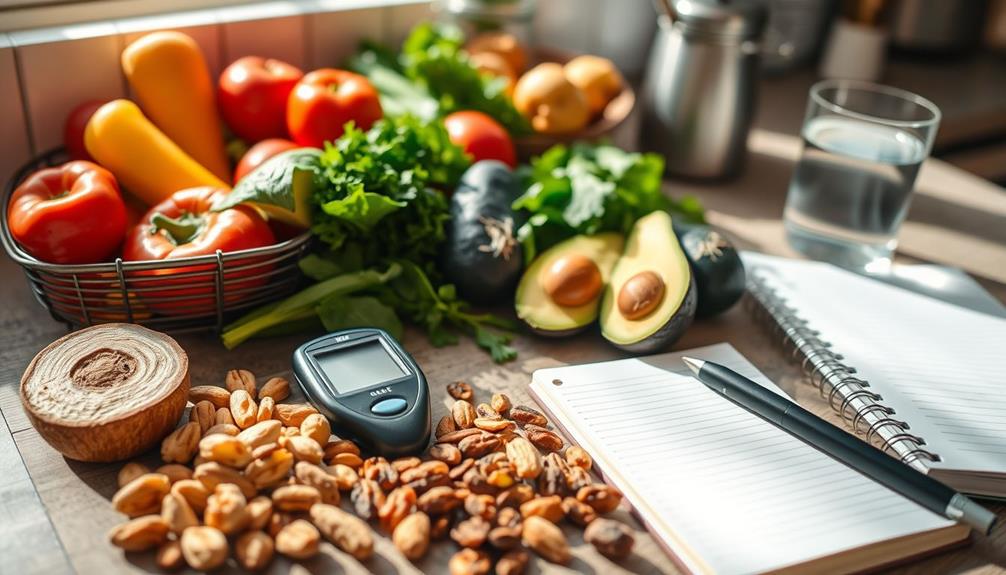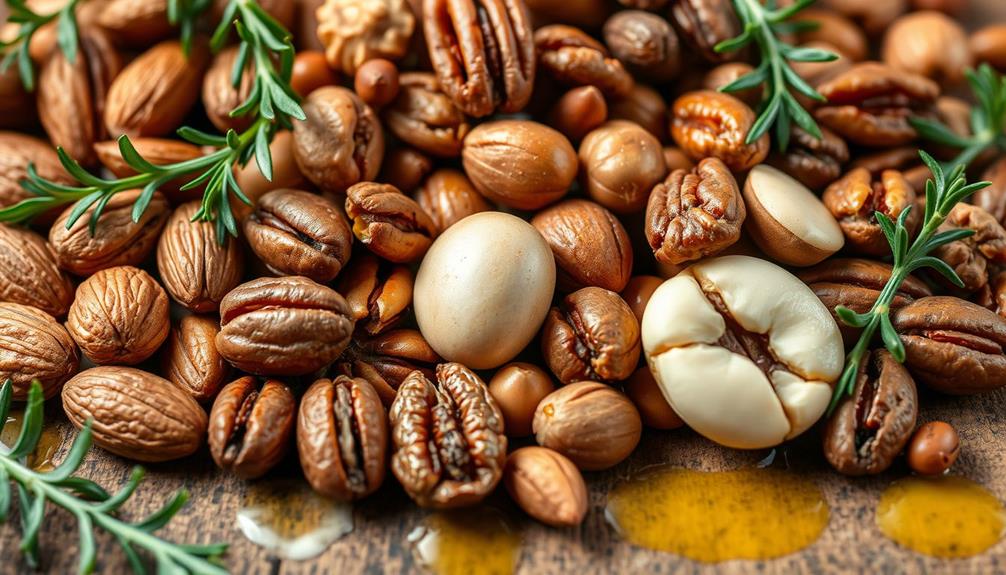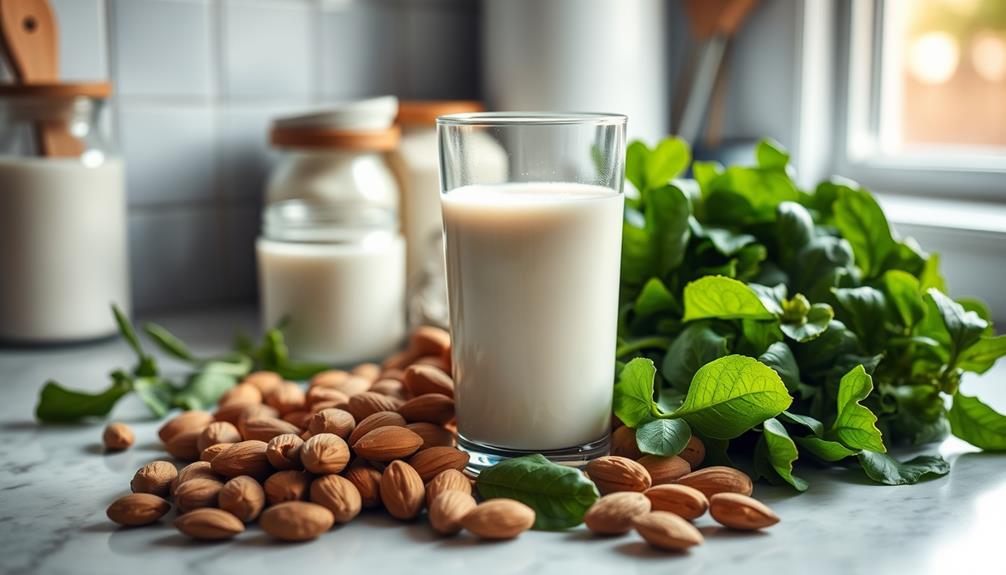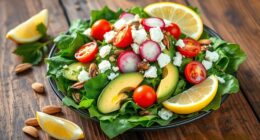If you're on a keto diet, grass-fed butter is your best bet. It's packed with healthy fats, omega-3s, and essential vitamins like A and K2. You'll reap benefits like better gut health and support for ketosis. Plus, it enhances the rich flavor of your dishes, making your meals more enjoyable. If you need a lactose-free option, clarified butter or ghee works great for high-temperature cooking. Looking for budget-friendly suggestions or vegan alternatives? There's so much more to explore, and tons of options to make your keto journey delicious and satisfying.
Key Takeaways
- Grass-fed butter is ideal for keto, offering high omega-3s, CLA, and essential vitamins while being low in carbs.
- Clarified butter (ghee) is lactose-free and has a higher smoke point, making it perfect for high-heat cooking.
- Coconut oil, rich in MCTs, aids in ketone production and is another excellent fat source for keto.
- Choose high-quality options like Kerrygold or Organic Valley for better nutritional benefits and flavor enhancement in dishes.
- Butter enhances flavor and provides healthy fats, supporting appetite management and energy levels on a keto diet.
Understanding Keto-Compatible Fats
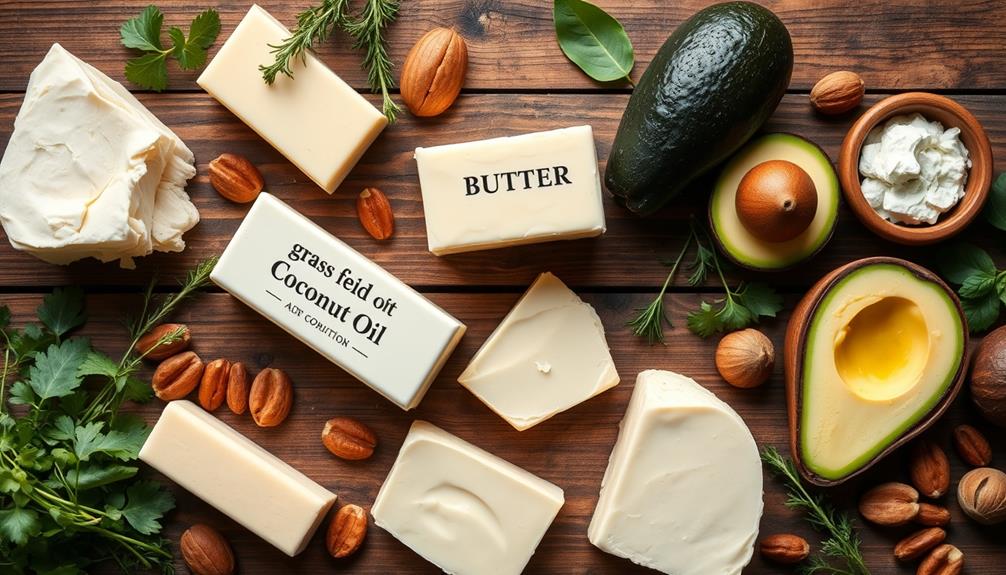
When diving into the world of the keto diet, understanding which fats are keto-compatible is vital for your success. You'll want to focus on incorporating healthy fats into your meals to maintain ketosis and promote fat loss.
Grass-fed butter is a fantastic choice; it's packed with omega-3 fatty acids and conjugated linoleic acid (CLA), both of which are beneficial for overall health. Additionally, butter is a source of vitamins A, D, E, and K, which are important for maintaining peak health on a keto diet.
Butter basics also highlight its versatility in cooking and baking.
Clarified butter, or ghee, is another excellent option. It's lactose-free and has a higher smoke point, making it perfect for cooking. Plus, it's rich in saturated fats, which are essential on a keto diet.
Don't overlook coconut oil, either. This versatile fat is high in medium-chain triglycerides (MCTs), which can help boost ketone production. It's solid at room temperature, so it works well in a variety of recipes.
Types of Butter
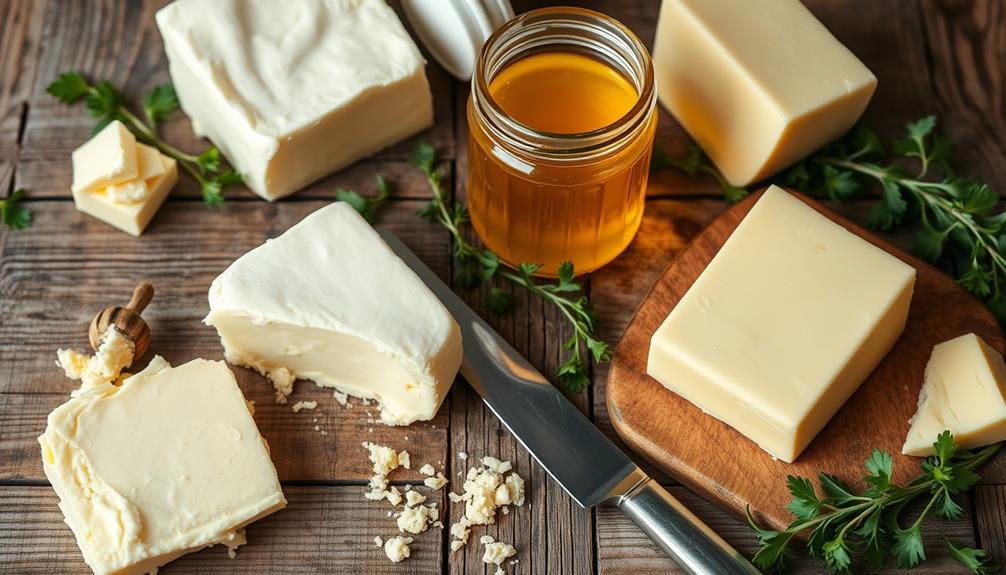
There are several types of butter that can enhance your keto diet, each offering unique benefits. When you choose the right butter, you not only add flavor but also boost your health.
For instance, incorporating options like grass-fed butter can provide a higher concentration of omega-3 fatty acids, which are beneficial for overall health.
Here are a few options to evaluate:
- Regular Butter: This unsalted option is made from cream and is perfect for cooking or baking, providing a rich flavor while being high in fat, which is ideal for keto.
- Grass-Fed Butter: Higher in omega-3 fatty acids and essential vitamins, this butter is a healthier choice that aligns with your keto goals.
- Clarified Butter (Ghee): With the milk solids removed, clarified butter is lactose-free and can handle higher cooking temperatures without burning.
You might also want to explore cultured butter for its probiotic benefits or organic butter for a more sustainable choice.
Each type of butter has its own advantages, making it easy to find one that fits your lifestyle. Embrace these options to elevate your keto diet while enjoying delicious flavors!
Nutritional Profile of Butter
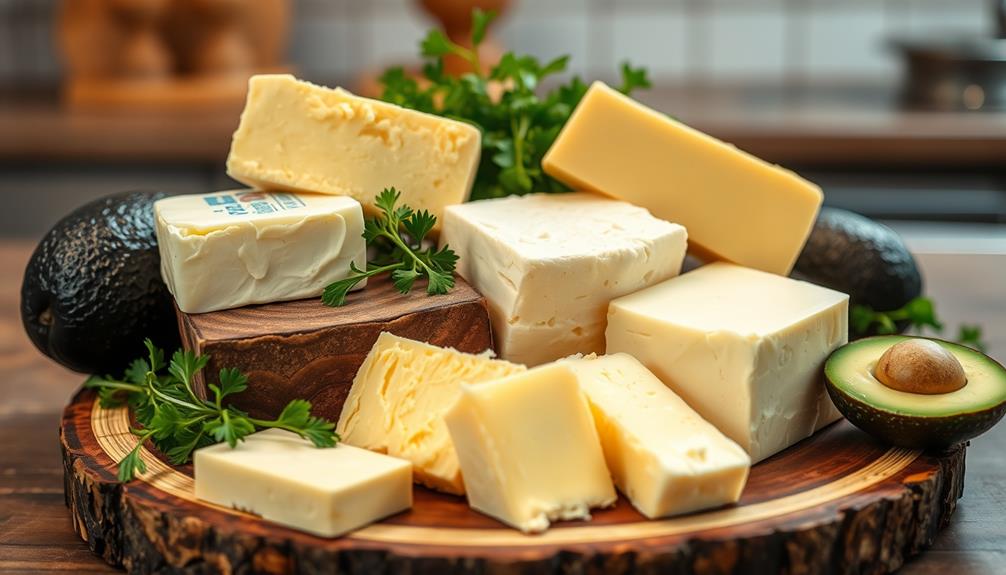
Butter packs a powerful nutritional punch, making it a staple for those on a keto diet. It's primarily composed of about 70% saturated fat, which provides the rich flavor and texture you love. Alongside saturated fats, butter contains around 25% monounsaturated fats, contributing to its unique profile with approximately 400 different types of fatty acids. This variety not only enhances flavor but also supports your body in various ways.
Additionally, incorporating healthy fats like butter can aid in nutrient absorption, including essential vitamins that support overall health, such as those found in essential oils for respiratory health.
If you're following a low-carb diet, butter is an excellent choice since it's low in carbohydrates. This makes it perfect for maintaining ketosis. Additionally, butter is packed with important fat-soluble vitamins, including A, D, E, and K, which play crucial roles in your overall health.
Opting for grass-fed butter can elevate your nutritional intake even further, as it boasts higher levels of omega-3 fatty acids and vitamins compared to regular butter.
Health Benefits of Grass-Fed Butter
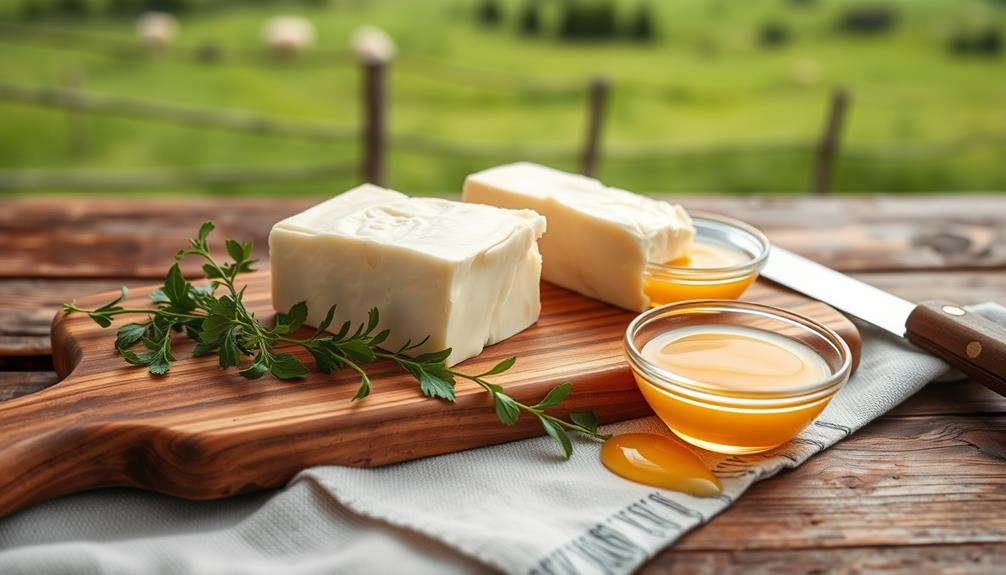
Grass-fed butter offers a multitude of health benefits that can greatly enhance your keto diet. By choosing this butter over grain-fed options, you're not just enjoying a richer flavor; you're also boosting your nutritional intake.
Grass-fed butter is higher in omega-3 fatty acids and vitamin K2, which support heart health and bone metabolism. Additionally, it provides a source of healthy fats, which are essential for maintaining ketosis effectively, making it a preferred choice for those on a ketogenic diet.
Common types of cold medications can also help in choosing the right supplements to complement your dietary choices.
Furthermore, it contains conjugated linoleic acid (CLA), known for its ability to reduce body fat and improve muscle mass. This makes it a fantastic choice if you're aiming for fat loss while following a ketogenic diet.
The presence of butyrate in grass-fed butter promotes gut health and has anti-inflammatory properties, benefiting your overall metabolic health.
Here are a few key benefits of incorporating grass-fed butter into your diet:
- Supports heart and bone health with omega-3 fatty acids and vitamin K2.
- Enhances fat loss and muscle gain with higher levels of CLA.
- Promotes gut health thanks to butyrate's anti-inflammatory properties.
Vegan Butter Alternatives
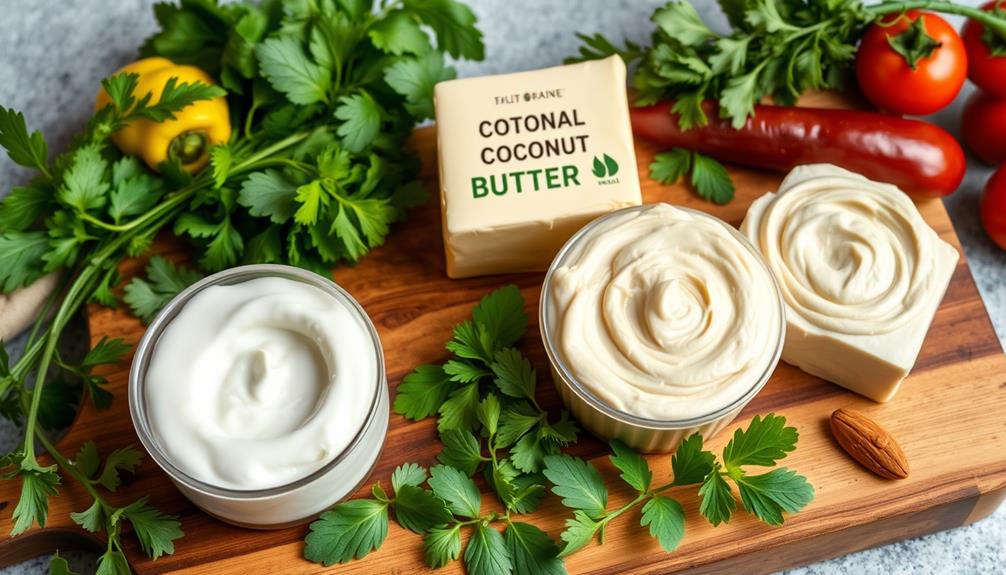
For those following a vegan diet or looking to reduce dairy intake, vegan butter alternatives can seamlessly fit into your keto lifestyle. One standout option is Earth Balance Vegan Buttery Sticks, which offers a dairy-free choice with low net carb content, priced at just $3.98 for a 1 lb package. This makes it accessible for anyone adhering to a keto-friendly vegan diet.
Additionally, incorporating these alternatives can help maintain your budget while sticking to your dietary preferences.
Another affordable choice is Country Crock Dairy Free Vegan Butter, available for $1.98 for 8 oz sticks. It's not only dairy-free but also suitable for various dietary preferences.
If you're interested in natural ingredients, consider Violife Plant Butter, which costs $3.48 for 8.8 oz and complements keto diets due to its low carbohydrate levels.
Many of these vegan butter alternatives, such as those from Earth Balance and Country Crock, also have EBT eligibility, making them accessible for low-income families.
Plus, they typically contain lower saturated fat levels compared to traditional butter while still providing the healthy fats necessary for a ketogenic lifestyle.
With these options, you can enjoy your favorite recipes without compromising your dietary goals.
Cooking With Butter on Keto
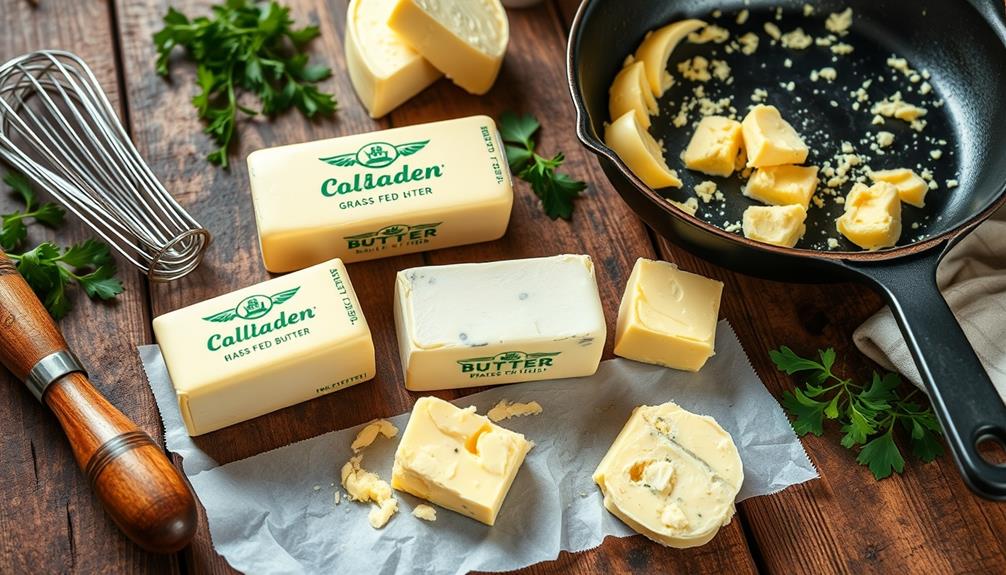
When you're cooking on a keto diet, choosing the right fats is vital for flavor and health benefits.
Butter not only enhances the taste of your dishes, but it also provides essential fats that support ketosis.
Additionally, incorporating fats like butter can help you manage your appetite and maintain energy levels throughout the day, making it a great choice for those on a ketogenic lifestyle.
Let's explore how butter stacks up against oils and the benefits it brings to your meals, including its potential role in natural remedies alongside conventional medications.
Benefits of Cooking Fats
Cooking with butter on a keto diet offers a rich source of healthy fats that can elevate your meals while supporting your nutritional goals. By incorporating butter, especially grass-fed varieties, you benefit from a concentrated source of omega-3s and essential vitamins.
Not only does butter have a high smoke point, making it suitable for various cooking methods, but it also retains its nutritional value better than lower-quality oils.
Here are a few key benefits of using butter in your cooking:
- Flavor Enhancement: Butter enriches the taste of your dishes, making keto meals more enjoyable.
- Metabolic Support: The saturated fats in butter can improve metabolic health and support your weight loss efforts.
- Gut Health: Butter contains butyrate, a short-chain fatty acid that may reduce inflammation and promote gut health.
Butter Vs. Oil Choices
Choosing the right fat for your keto cooking can greatly impact both flavor and health benefits.
Butter, especially grass-fed butter, is a fantastic option with its high healthy fat content and zero carbs, delivering 102 calories and 12g of fat per tablespoon.
If you're planning to cook at higher temperatures, consider clarified butter (ghee), which has a higher smoke point of 450°F and remains lactose-free, packing 112 calories and 13g of fat per tablespoon.
Coconut oil is another popular choice for keto enthusiasts. It's rich in medium-chain triglycerides (MCTs) that boost ketone production, offering 121 calories and 13g of fat with zero net carbs per tablespoon.
This oil has a smoke point of about 350°F, making it versatile for various cooking methods.
Extra virgin olive oil is excellent for sautéing and salad dressings, too. With 124 calories and 14g of fat per tablespoon, it's loaded with heart-healthy monounsaturated fats.
However, keep in mind its lower smoke point of around 375°F compared to ghee and coconut oil.
Choosing the right fat not only enhances your dishes but also aligns with your keto goals.
Flavor Enhancements in Dishes
Butter adds a delightful richness to your keto dishes, considerably enhancing their flavor profile. When you choose high-quality butter, such as grass-fed varieties, you not only boost flavor but also increase your intake of healthy fats, omega-3 fatty acids, and vitamin K2. These additions contribute to your overall health while keeping carbs low.
Utilizing clarified butter or ghee is another excellent option, as it raises the smoke point, making it perfect for sautéing and frying. The nutty flavor it imparts elevates any dish. Adding butter to vegetables, meats, or seafood creates a luxurious mouthfeel, ensuring your meals remain satisfying and low in carbs.
Here are some delicious ideas to enhance your dishes with butter:
- Garlic Herb Butter: Mix butter with garlic and fresh herbs for a flavorful sauce.
- Melting Butter: Drizzle melted butter over grilled steak for an intense flavor boost.
- Finishing Touch: Use a pat of butter on steamed asparagus to add creamy richness.
Incorporating butter into your cooking not only elevates flavor but also aligns perfectly with your keto dietary goals.
Recommended Butter Brands
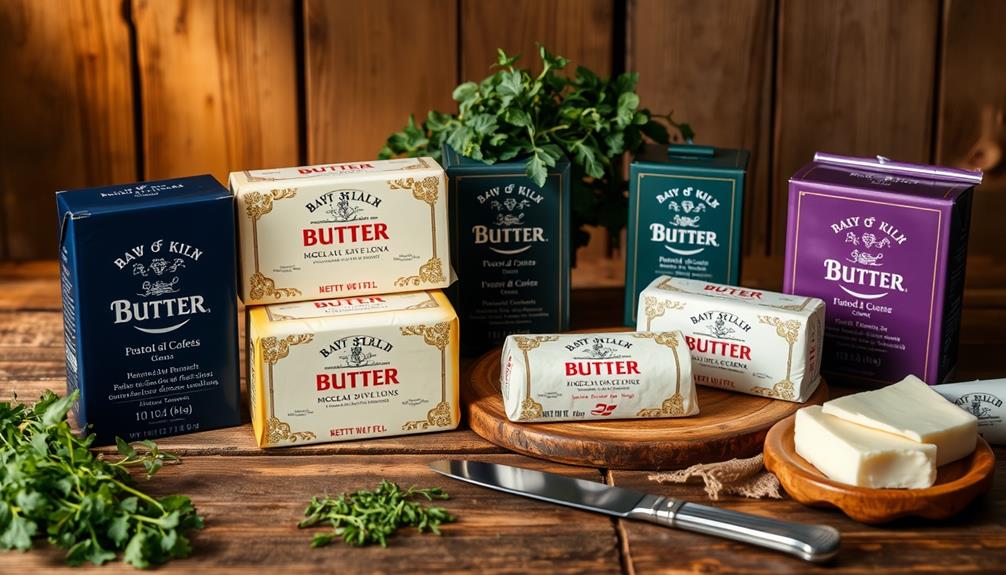
When it comes to finding the best butter for your keto diet, several brands stand out for their flavor and nutritional benefits. One popular option is Kerrygold butter, known for its rich, creamy taste and high fat content, making it a great choice for a keto diet. Another top contender is Organic Valley butter, which is organic and grass-fed, providing a richer flavor and higher levels of omega-3 fatty acids. Additionally, for those looking for ketofriendly rice options, brands such as 4th & Heart and Bulletproof offer varieties made from grass-fed cows, which provide additional nutritional benefits for a keto diet.
Kerrygold Grass-Fed Butter is a top choice, thanks to its high omega-3 fatty acid content and CLA, promoting fat loss with 102 calories, 12g of fat, and 0g of carbs per tablespoon.
For a clean ingredient list, try Organic Valley Unsalted Butter, made from cows not treated with antibiotics, offering a wholesome option for your butter keto needs.
If you're looking for a budget-friendly option, Challenge Unsalted Butter provides rich flavor and high animal fat content at just $5.68 per pound.
For those on a vegan keto diet, Miyokos Cultured Vegan Butter is an excellent alternative, containing 11g of fats and low net carbs per 14g serving.
Another great plant-based choice is Earth Balance Vegan Buttery Sticks, available for $3.98 per pound, delivering healthy fats while keeping your diet on track.
With these recommended butter brands, you can enjoy delicious flavors while staying committed to your keto lifestyle.
Frequently Asked Questions
Which Butter Is the Best for Keto?
When you're choosing butter, consider grass-fed options for their higher omega-3s and CLA. Clarified butter offers a lactose-free alternative, while regular butter fits your low-carb needs. Prioritize organic varieties to maximize quality and health benefits.
Can You Eat Butter on a Keto Diet?
You can absolutely eat butter on a keto diet! With about 12 grams of fat and zero carbs per tablespoon, it's a perfect energy source that seamlessly enhances your meals while supporting your dietary goals.
Is Butter or Olive Oil Better for Keto?
When considering butter or olive oil for keto, it really depends on your preferences. If you love a creamy flavor and high-temperature cooking, go for butter. If you prefer heart-healthy fats, olive oil's your choice.
Is Country Crock Butter Keto Friendly?
Think of Country Crock Butter as a ship sailing away from keto shores. It's not the best choice for your diet; its vegetable oils and carbs can steer you off course. Always check labels for specifics.
Conclusion
Incorporating the right butter into your keto diet can be like choosing the perfect paint for a masterpiece; it enhances flavor and brings your culinary creations to life. Just as an artist selects hues that complement each other, opting for high-quality, keto-friendly butters can elevate your dishes and support your health goals. Whether you go for grass-fed or a vegan alternative, remember that butter isn't just an ingredient; it's a key player in your keto journey.
